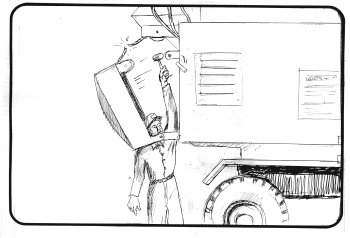COAL MINE FATALITY - On December 9, 1999, a work crew consisting of three persons were preparing a 75-ton mobile crane for transport from the mine property. Prior to the crane operator securing the top of the 6-ton counterweight by removing the slack in the attached wire rope, the victim, who was positioned between the counterweight and the crane, removed the two pins holding the top of the counterweight to the back of the crane. This action immediately released the top of the counterweight allowing the top to rotate away from the crane while pivoting around the bottom hinge point (the bottom pins), creating a pinch point and catching the victim between the counterweight and the crane. Also, at some point during the rotation of the counterweight away from the crane, both the wire rope attached to the top of the counterweight, and the clevises attached to the two remaining bottom pins failed, releasing the counterweight to fall to the ground.
The work crew involved in the accident was employed by a construction company contracted to load longwall equipment for transport from the surface area of an underground coal mine.
 BEST PRACTICES
BEST PRACTICES
Workers shall stay clear of hoisted loads and avoid pinch points when working on or near moving equipment or machinery.
Workers should follow safe work procedures consistent with the design of the equipment when working on or near such equipment.
This is the 31st fatality reported in calendar year 1999 in the coal mining industry. As of this date in 1998, there were 26 fatalities. This is the fourth fatality classified as Machinery in 1998.
For more information:
 MSHA's Fatal Accident Investigation Report [FTL99C31]
MSHA's Fatal Accident Investigation Report [FTL99C31]

MSHA's Fatal Accident Investigation Report [FTL99C31]
